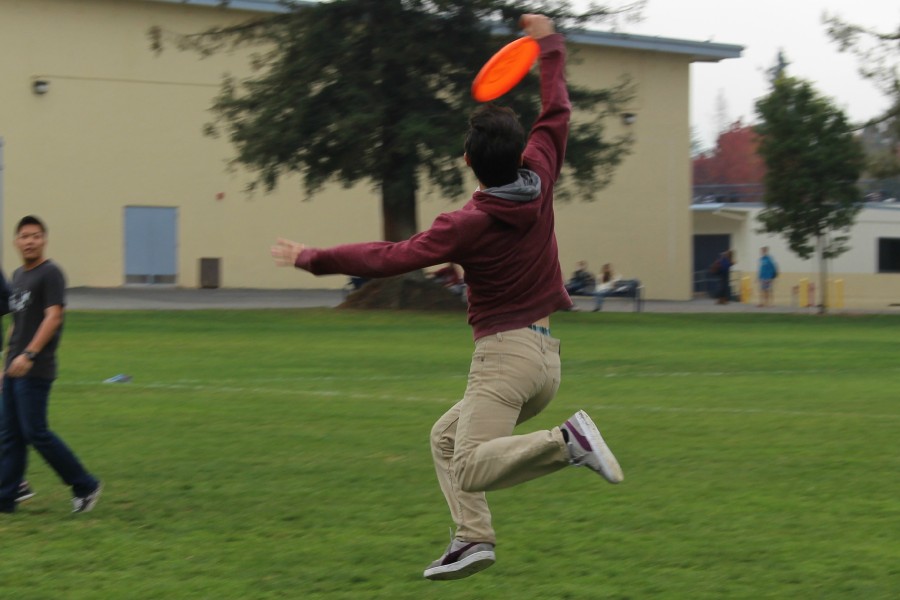It’s time for recreational sports
Students play ultimate frisbee during lunchtime. Recreational sports like ultimate frisbee are beneficial to students both as a way to relieve energy and as a way to provide peace of mind to often stressed out students.
It’s dodgeball season, and the campus buzzes with special energy over the daily lunchtime tournaments. Students pummel each other with rubber balls while an announcer tallies every point, hit and miss. It’s an exciting activity that gets students’ blood pumping while also boosting their moods, so it only makes sense that the school should strive to establish more of these activities. All students will reap the benefits of recreational sports on campus if there are more opportunities to get involved.
It’s scientifically proven that staying active during the day boosts mental and physical health. According to the Washington Post, fitter students score higher on tests than less-active ones.
“People really enjoy that euphoric aspect of a runner’s high and the clarity of mind you get from a routine workout,” neuroscientist at the University of Victoria in British Columbia Brian Christie said in a Washington Post article. “If you go out for a walk, your stress levels usually plummet. And that’s when the answer comes to you.”
Members of the Ultimate Frisbee team, which is one of the larger recreational teams on campus, vouch for the relaxation this activity gives them.
“It definitely helps me reduce stress,” team member senior Sam Morimoto said. “It’s a great way for me to relax a bit in the middle of the school day.”
Many factors influence students’ ability to participate in after-school sports. In many cases students often don’t have enough time or resources to make the commitment. With recreational sports, students can play during the school day and enjoy the sport without worrying about attending practices or games or performing at a certain level.
“I like it because it’s a really fun sport and there’s not really any commitment,” team member senior Ashwin Krishna said. “It’s just a club, and so you can just go and play whenever you want. There’s no required practices or anything, and it’s just fun to play with other people I wouldn’t usually talk to.”
The campus has a natural separation of differing social groups and grade levels. It’s the result of a variety of systematic problems which could be alleviated by recreational sports.
“I’ve made a lot of new friends [through playing ultimate for four years],” Ashwin said. “Especially as a freshman, I [connected with] seniors and juniors that I wouldn’t normally have. It’s just a good way to connect with other people.”
As the school becomes more connected, students will have more empathy and support for all students in addition to being less stressed, more healthy and most importantly, more involved within the school.
Such a program would improve more than just students’ quality of life. Research has shown that frequent exercise actually enhances students’ academic ability, reducing stress on the brain that improves capacity for cognitive function in the long term.
The first step towards establishing more recreational sports on campus begins with the student body. ASB is active and experienced in organizing recreational activities, and with enough interest from students, it can help set up a sports equipment bin for all students to use during brunch and lunch.
“I definitely think it’s feasible,” senior ASB activities commissioner Nate Spencley said. “It’s not very expensive to buy a few balls and some equipment for students to use. And I don’t think it would be difficult to have maybe teachers sign up for shifts every once in a while to watch students and make sure they return the balls. So I don’t think it’s too difficult of a project to undertake.”
The check-out system would likely entail students leaving their backpacks in a teacher’s classroom in return for balls and other equipment after lunch or brunch. A teacher or staff member would have to use lunch to facilitate this system, but that would require relatively minimal effort in exchange for so many benefits to the student body.
“[The administration] would maybe have to manage sharing [facilities] if there were two groups that wanted to play field hockey or [another sport],” Assistant Principal Galen Rosenberg said. “The challenge for the school is always the supervision and responsibility for [equipment] part… If we’re going to check out basketballs or street hockey equipment, how do we have a system that’s manageable to make sure we get it back, and if it’s broken, then who’s responsible? That’s not to say it’s not impossible.”
P.E. instructor Kiernan Raffo said that the P.E. department has the equipment and motivation to set up such a system with ease, so for students who stay on-campus during lunch, sports equipment could become a noontime staple.
The mental and physical health benefits are undeniable, and the boost in social connections on campus will help our school environment. So let’s get out of our seats, meet some new people and create a better campus for all.



